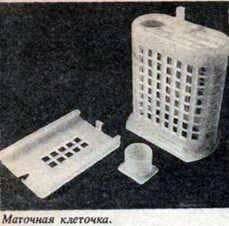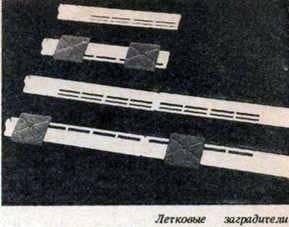
Universal separation grid.
In the kit two pieces in the size of 448X470 mm. They are designed for standard 10- and 12-ram hives. For installation in a 10-frame hive, it is sufficient to break off part of the grid. Twelve thin ribs greatly facilitate the transition of bees from the nesting part of the hive to the shop top and back, its installation practically does not affect the air exchange inside the hive, and consequently, on the microclimate in the family.
Individual elements of the grid can be used as light barriers, treads and for the manufacture of self-made insulators.
It is very convenient to assemble propolis with it. To do this, two small pieces of the lattice must be folded and, by shifting them halfway across the width of the cell, fastened with a wire and put on the canvas, in which the window is cut first. The grinded grilles are placed in the freezer, and then, crushing the propolis, hitting them on a flat surface.
During the withdrawal of queens and the collection of royal jelly, we recommend using artificial bowls, a working grafting table, which is the base of the set of bowls and the uterine cage KMS-1.
The optimal size of the bowl, the spherical bottom provide a good inoculation and ideal conditions for the detachment of the queen cells and the development of the larva. Misochki conical rods inserted into the holes (03 mm) laths inoculation frame and placed in the family.
Misochki with rebuilt queen cells are fixed in the uterine cell. To do this, the bowls are inserted into the hole of the lid or into the side slit, and then the lid with the mother liquor is placed on the upper part of the cell in its entire length and with a slight pressure of the finger is fixed with the help of the side edge and the slot.

The kit includes two feeder-plugs. The cell has a pin for fitting into the holes (03 mm) of the inoculum strips.
The uterus from the cell leaves through the hole for the cork-feeder, which, after removing the plug, is closed by a wax.
The cell is made of food polyethylene; other products – from food polystyrene. Easily cleaned and disinfected by soaking and washing in a 5% soda solution, followed by rinsing with warm running water.
Two types of flight guards, complete with straps for fastening with carnations on the upper and lower flaps (only ten parts), can prevent the swarm from escaping if there is no beekeeper in the apiary, protect the family from rodents, and isolate the family during transportation or suspected chemical treatment of crops.

Through single-row slots only workers can pass. Valves with double-row slots provide ventilation, but do not allow bees to exit the hive.
Stops on one side of the slats serve as handles when moving the valves.
It is possible to install the valves in an inverted position for adjusting the length of the slot.
The kit can be used for hives with a length of up to 250 mm.
The dust collector is made of four parts. In its design, there is a joint installation of flight barriers and a pollen trap.

The pollen grating and the tray for renovation are made of food polystyrene, the body and cover made of thin galvanized steel sheet, painted in different colors.
Яблоки моченые с медом. Глаза пчелы фото.
Fixtures and fixtures